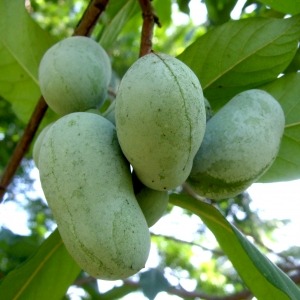Pawpaw Is 2021 State Arboretum Tree of the Year
Native tree produces large, edible fruit
On Arbor Day, April 30, the pawpaw was named the 2021 State Arboretum Tree of the Year. The celebrated native fruit tree hosts the spectacular zebra swallowtail butterfly -- and also bears fruit used in ice cream and other desserts (as well as bourbon cocktails)No time is more fitting than Arbor Day, April 30, for the State Arboretum of Virginia at Blandy Experimental Farm to announce its third Tree of the Year: the pawpaw (Asimina triloba). The Arboretum’s 2021 Tree of the Year was selected after deliberation by Curator T’ai Roulston, Blandy arborists, and Virginia Department of Forestry representatives.
According to Curator Roulston, pawpaw was selected for its value as a native fruit tree, a butterfly host plant and its lush foliage. It produces hand-sized edible fruit prized by many people for its mango-like taste and banana consistency. The fruit is also prized by wildlife, like squirrels, raccoons and opossums, when it falls in September. It showed such promise as a commercial fruit in the early 20th century that there was a national effort to propagate the best ones for mass consumption. A major obstacle was its short shelf life, however, and it has remained a local seasonal fruit to seek out each year. It’s been featured in ice creams and other desserts as well as bourbon cocktails.
While people appreciate the pawpaw's large leaves as a source of shade along riverbanks, one of our most spectacular butterflies owes its life to them: they serve as the host plant for the zebra swallowtail, one of our larger and more striking butterflies.
The pawpaw grows 15-30 feet tall, has few problems with pests or disease, and grows well in sun to moderate shade. If you want fruit, you will have to plant trees of at least two different cultivars.
On Arbor Day each year, the State Arboretum of Virginia honors one extraordinary species of tree as its Tree of the Year. The goal of the program is five-fold:
■ To remind us of the value and environmental significance of trees in Virginia and beyond
■ To educate the public about the variety of trees in Virginia
■ To nurture a love of trees in all ages
■ To promote important tree education, science, and conservation at the State Arboretum and elsewhere in Virginia
■ To join with others in awe of the majesty of Virginia’s trees
“We want everyone – of all ages – to know how important trees are to us environmentally,” says Roulston. “Every day at the Arboretum we practice and promote tree education, science, and conservation through research and public programming. That’s a vital part of our mission.”
In selecting the Tree of the Year, these key traits are considered:
■ Does the tree have a compelling story or uniqueness? Does it have special characteristics – for example, color or leaf structure – that make the tree an interesting choice?
■ Is the tree readily available for purchase in Virginia at most nurseries?
■ Is the tree familiar to most gardeners?
■ Is the tree easy to grow and nurture for nonprofessionals and will make a good addition to a residential landscape?
The State Arboretum of Virginia’s 2019 Tree of the Year was the eastern redbud. For 2020, the State Arboretum chose the sassafras as the Tree of the Year.
About the State Arboretum of Virginia:
The State Arboretum of Virginia is home to more than 5,000 woody trees and shrubs, including a unique 300-tree ginkgo grove and a Cedar of Lebanon allee. The Arboretum staff and many volunteers across the state help to grow the collection each year by planting new and replacement trees.
The Arboretum is part of historic Blandy Experimental Farm, a research field station for the University of Virginia’s Department of Environmental Sciences. Blandy Experimental Farm is on Route 50 in Clarke County, about 10 miles east of Winchester and 20 miles west of Middleburg. Directions and a calendar of events are online at http://blandy.virginia.edu.
|

